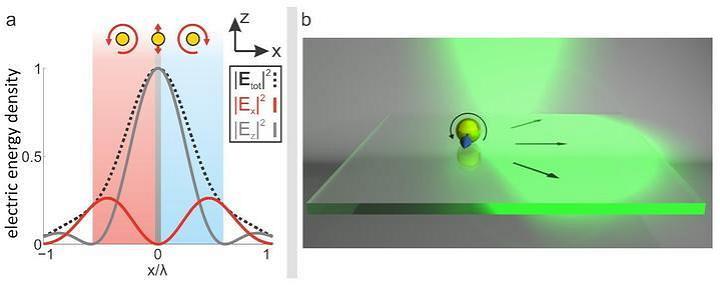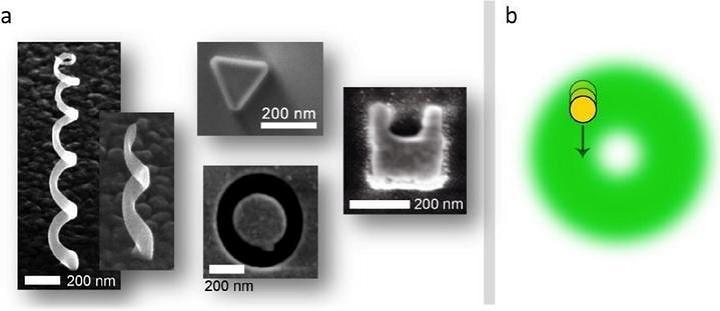 A source has tipped us off to a possible precursor for an “atomic precision” 3D printhead where the interaction of tailored light with a single atom and individual nanostructures combine to create remarkably accurate results.
A source has tipped us off to a possible precursor for an “atomic precision” 3D printhead where the interaction of tailored light with a single atom and individual nanostructures combine to create remarkably accurate results.
At the Max Planck Institute for the Science of Light, this approach is utilized to couple light to a single atom, or for that matter, to individual nano-particles. The research demonstrates that light can be coupled to an ion trapped within a parabolic mirror, and the upshot is a high efficiency, optimized polarized beam.
The researchers, led by Dr. Gerd Leuchs, say that as individual atoms, ions and molecules form the basic building blocks of matter, our perception of the tangible materials formed from such building blocks through their interaction with light is key to our ability to manipulate them.
Complex objects such as nanostructures can be built and manipulated by understanding specific interactions they have with a light field. The manipulations may well prove to serve as the basis for potential applications in biophysics or quantum information processing, and the individual nanostructures themselves may serve as “building blocks” to create metamaterials.
The process involves the creation of radially polarized light which is acutely focused. This incoming beam, which features a cylindrical symmetry, tracks across a path incident from right to left onto a lens. The focusing rotates the individual electric field vectors towards the optical axis, and they then interfere within the focal point to create an electric field component which oscillates along the optical axis.
The result is a tailored light where the precise shaping of the temporal and spatial distribution of the intensity of the light – and the polarization vector or direction of oscillation of the electric field – can then be concentrated to dimensions smaller than the wavelength of the light when focused onto a target object.
A radially polarized ring is focused with a parabolic mirror, and in this experiment, the researchers generated the tailored, radially polarized mode to an ideal field distribution down to 98%.
The work uses a “singly charged ytterbium ion” as the atom, and the ions can be accurately positioned, and even “trapped” for varying periods using an electrode arrangement and an applied AC voltage. An ion trap was developed to the parabolic mirror geometry which effectively shadows the ion from the focused light with minimal interference.
MPI says the methodology has been successfully applied to the investigation of numerous nanostructures and nanoscopic objects to create metamaterials of extraordinary properties.
What it might mean is that, by “holding” a single atom with laser beams, it may well be possible to build a 3D printhead with singular atomic precision.
With the aid of artificial materials, light can be guided around objects and reflections can be suppressed to form a “nanobeacon.” The researchers say such light sources pave the way for high-precision control of light propagation in a range of optical networks.
Do you forsee a coming say when 3D printers which feature precision down to the level of a single atom could be created using this nanobeacon technology? Let us know in the Nanobeacon forum thread on 3DPB.com.
Subscribe to Our Email Newsletter
Stay up-to-date on all the latest news from the 3D printing industry and receive information and offers from third party vendors.
You May Also Like
Further Understanding of 3D Printing Design at ADDITIV Design World
ADDITIV is back once again! This time, the virtual platform for additive manufacturing will be holding the first-ever edition of ADDITIV Design World on May 23rd from 9:00 AM –...
3D Printer Maker EVO-tech Reborn as NEVO3D — Once More With Feeling
EVO-tech was a 3D printing service and original equipment manufacturer established in 2013 and based in Schörfling am Attersee, Austria. The company produced high-quality material extrusion systems featuring linear bearings,...
3D Systems Brings 3D Printed PEEK Cranial Implant to the U.S. with FDA Clearance
For more than 10 years, 3D Systems (NYSE:DDD) has worked hand-in-hand with surgeons to plan over 150,000 patient-specific cases, and develop more than two million instruments and implants from its...
CDFAM Returns to Berlin for Second Annual Symposium
The second CDFAM Computational Design Symposium is scheduled for May 7-8, 2024, in Berlin, and will convene leading experts in computational design across all scales. Building upon the first event...

































